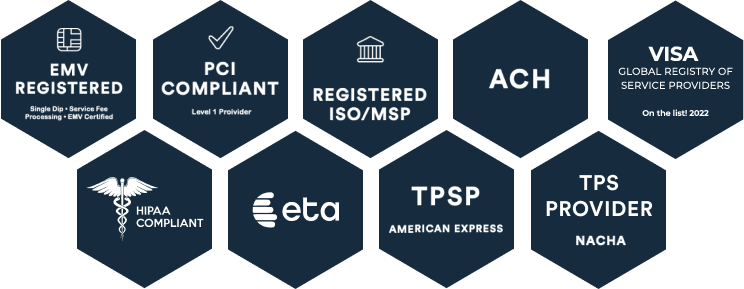If there’s one thing we’ve learned over the past several years, things can change rapidly in the tech world. And every time we push the boundaries of technology further, we raise consumer expectations. This is a formula that applies to payment processing technology across several industries.
Keeping up with those advancements and trends is critical to:
- Stay relevant to your consumer
- Meet their expectations
- Provide adequate security
- Offer convenience
- Increase efficiency
In this article we’ve broken down the top payment processing trends across different industries and highlighted their unique value offerings.
Top 12 Upcoming Payment Processing Trends by Industry
When discussing trends in the payment space, it can be helpful to isolate individual industries. Since each industry handles billing practices differently, separating them can offer additional clarity. Here are some interesting payment-related trends surfacing in local government, healthcare, higher learning, and corporate spaces.
Government Payment Processing Trends
Financial systems in government organizations tend to evolve slower than their corporate counterparts, but that doesn’t mean change isn’t continually happening. These are the top three payment processing trends to watch for in government organizations this coming year.
1. Artificial Intelligence (AI)
This isn’t a trend exclusive to government organizations, but it’s on the rise within the sector. You can find increased use of AI technology wherever you look today and payments haven’t gone untouched. Government organizations are seeing the benefit of implementing processing platforms that incorporate AI into their system.
2. Mobile Payment Processing
It’s not news to anyone that mobile payments are on the rise across businesses. Government organizations have traditionally relied on paper systems and online payment portals, but recently more agencies are expanding their offerings to include mobile payment processing.
3. Renewed Focus on Cybersecurity
There are few industries where security isn’t critical. For government, security remains a top concern. With the implementation of increased PCI regulations and other security measures, government agencies can expect to see a renewed focus on cybersecurity in their financial systems in the upcoming year.
Healthcare Payment Processing Trends
The healthcare industry has been hit hard over the past couple of years. The COVID-19 global pandemic put increased pressure on facilities to expand their offerings and offer increased flexibility. Their billing processes didn’t escape the sweep of innovations across the field. In 2023, we can expect that to continue to evolve in the following ways:
1. Embedded Payments
Embedded payment options are digital payment options embedded in non-payment apps. They operate on a closed-loop, which means the merchant “owns” the complete transaction. You can find embedded payments on a final checkout page, through text-2-pay solutions, and other flexible payment options.
This is a trend we’ll see continue to evolve across multiple industries, but the healthcare industry is seeing them become increasingly relevant.
2. Reduction in Payment Friction
With the critical expansion of capacity undergone by the healthcare industry over the past few years, it’s no surprise that many systems had to be entirely redesigned, which included billing across facilities. The main objective of this process is to streamline and simplify the payment experience for patients.
Reduced friction in the payment process is an initiative that will continue into 2023.
3. Expanded Payment Options
Along with the other prominent payment trends greeting the healthcare industry in 2023, we’re going to see an expansion in overall payment options offered. When businesses began offering options such as text-2-pay, IVR phone payments, mobile payments, and other innovative offerings, they set the standard.
In the upcoming year, you can expect to see the healthcare industry (and most others as well) expand its payment options to meet those evolving expectations.
Higher Learning Payment Processing Trends
Higher education institutions have also been hit with many changes over the past few years. Many institutions are adjusting their billing practices to match these changes. In this section, we touch on some reasons why you’ll see changes in the coming year.
1. Increased Affordability
Higher education costs have been on the rise for the past decade. Recently, we’re seeing increased efforts to make education more financially accessible. Because of the added pressure, we expect to see this trend bleed into billing practices.
This may mean making the payment process easier and more accessible, adding payment plan options for increased flexibility, and expanding digital payment options.
2. Shifting Demographics and Expectations
A lot of the push for a change in the financial processes of higher education institutions comes from shifting demographics and expectations. With Gen Z entering college and coming in with their established expectations for more accessibility, convenience, and flexibility, higher learning facilities have to adjust their offerings to accommodate.
3. Online Education and Digital Payment Processing
Another reason the higher education industry must take a hard look at its billing practices is because of the educational shifts we’ve seen over the past couple of years. When the pandemic forced most students into online education, institutions were required to expand their offerings and services to meet that need.
This is when digital payment processing advancements entered the scene. We don’t expect that to slow down as we move into the new year.
Corporate Payment Processing Trends
Corporate business is often the first place you can see a rising emergence of trends. When it comes to payment processing, it is a great place to identify up-and-coming trends that other industries may adopt in the coming years.
1. B2B Payments Move to Digital Platforms and Wearables
The topic of digital B2B payments has been prominent in business conversations for a while now, and in 2023 we can expect to see it take flight. B2B transactions have notoriously been handled in traditional ways, which can be cumbersome. As we move into the new year, more and more B2B transactions and payments are transitioning to digital platforms, including wearbles.
2. Buy Now, Pay Later
Specifically speaking to the eCommerce space, you’ve likely seen this trend across your favorite online stores and when you’ve made larger purchases. The increase in demand for buy now, pay later options is radically changing the corporate landscape. When talking about increasing the convenience and flexibility of a company’s payment processing options, this is an effective trend.
3. Engaging Commerce
As more and more businesses work to enhance the customer experience, we’re seeing a rising interest in engaging commerce practices. Companies are focusing on connecting with their customers at every stage of their life cycle within the organization. That includes online check-in systems, loyalty programs, online appointments, digital marketing, and more.
In payment processing, that means paying special attention to the needs of customers and providing additional touch points along their journey.
Learn All About Modernizing Payment Experiences With CORE
All of these payment processing trends encapsulate the idea of modernizing billing experiences for consumers. For government agencies, that means that the days of constituents paying their bills by mail are long gone. Are you meeting your residents’ expectations?
CORE is dedicated to providing the resources you need to modernize your payment processing systems.






